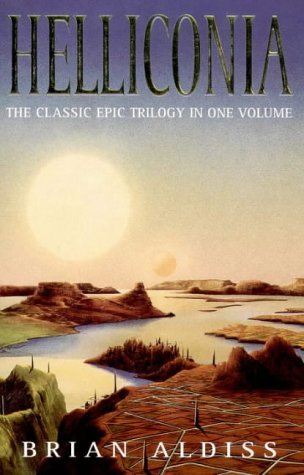Brian Aldiss, Helliconia: Spring, Summer and Winter (1982, 1983 and 1985)
Science Fiction is the literary equivalent of marmite: you either love it or you hate it. So it is with some trepidation that I admit to currently reading (actually re-reading) a great example of Environmental Sci. Fi. Brian Aldiss’s trilogy is about a world where the laws of nature are so extreme that they cast into stark relief a whole range of questions about the possible limits of human development. The three books explore the long term role of religion, the impact of pandemics (so they are nothing if not relevant at the moment), the enervating effects of technology, and even the impact of time on History.
I remember a friend recommending the series to me away back in 1985. We were both incredibly naïve 16 year olds with the sort of haircuts that only a 10 week lockdown could excuse these days. I remember we were very excited by Green Party politics and the seeming breakthrough success of the Greens in Germany at the time. In other words I came across Helliconia as a sort of manifesto for greater environmental consciousness rather than as a work of Sci. Fi. per se– that is my excuse at least and I am sticking to it.
The basic premise is that c. 5,000 years from now interstellar exploration from Earth has found an earth-like planet, Helliconia. Living there are two competing sentient life-forms: cattle-like creatures called Phagors and populations that constitute an entirely separate evolutionary branch of humanity. The fate of both is determined by the planet’s astronomy. The planet and its ‘local’ sun entered the gravitational pull of much a larger star millions of years previously, only to settle into an elliptical orbit around this new sun which lasts 2,592 years. This ‘Great Year’ means a season will stretch for centuries. The conceit enables Aldiss to accentuate the effect of environment on individuals, societies, their religions and their histories.
In the first book the planet is emerging from an 800 year winter during which Phagors have been wiping out or enslaving humans in an uncoordinated fashion. Most human communities have regressed into hunter gathering groups of not more than 20 or 30 people. However, two or three larger power centres have endured. Their expansion in the spring coincides with a seasonal virus pandemic which in effect regulates the planet’s biomass during periods of extreme climatic flux. The first and second books are all about the relationship between environmental conditions, natural resource exploitation, technology, and the role of religion and secular knowledge in state- and societal-formation.
The second book is set about 600 years later in the summer, when Helliconia is nearing the closest point in its orbit to the large star. Processes of religious centralization and regal unions produce kingdoms and empires which begin the systematic elimination of Phagors. But religious schism and rapid technological innovation, especially gunpower weapons, destabilize and fracture these polities.
The third book is set a further eight centuries on. As Helliconia slips back into winter Phagors adopt a more determined attitude to wipe out humans once and for all. As the climate deteriorates arable and pastoral economies begin collapsing, leaving marine resources key to the survival of the embattled population centres. Aldiss stresses that the fundamental problem is not the changing environment or even the episodic outbreak of deadly diseases, but the limitations of collective responses to these developments. It is safe to say that recent events underscore the value of that basic but important point. He deliberately leaves the fate of Helliconia’s humanity unclear – but it isn’t looking good.
Woven through the fantasy storyline are a set of mediations about how humans individually and collectively struggle to accept and adjust to their lack of control. Many aspects of government, religion and technology seem to provide only partial and always short term solutions to the environmental forces governing physical existence. Now all this might sound a bit bleak: but if nothing else Helliconia, with its 800 year winters and its 400 year long summers, might help put lockdown into perspective.


